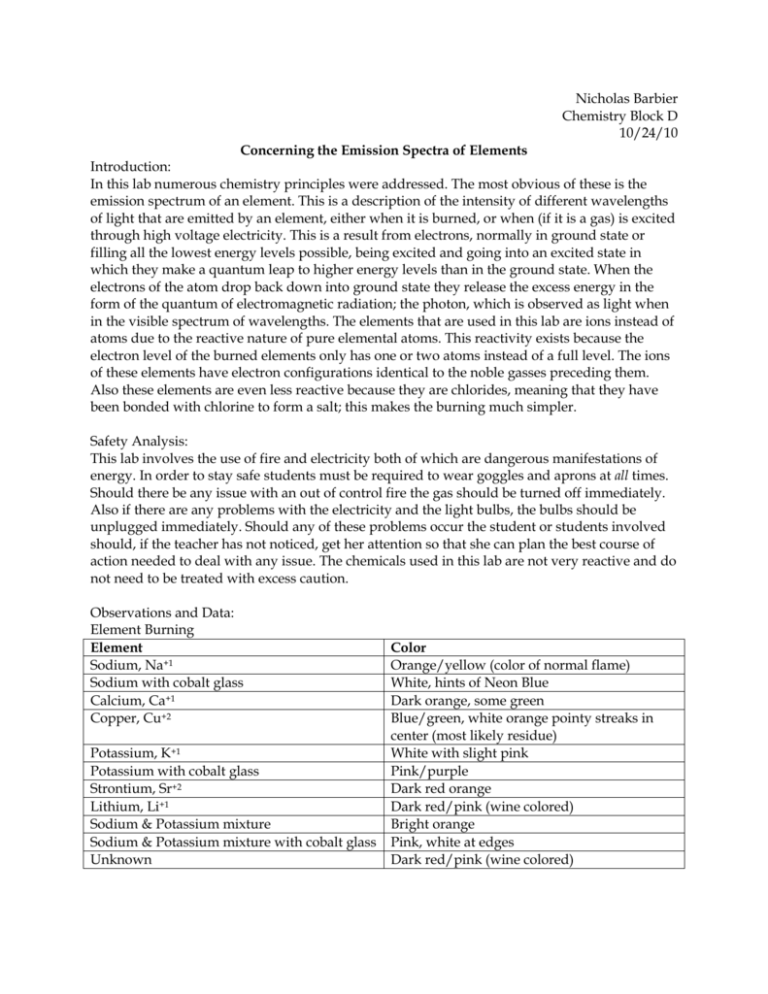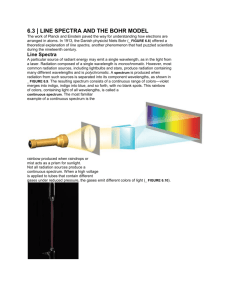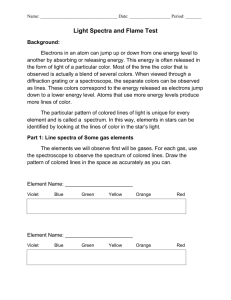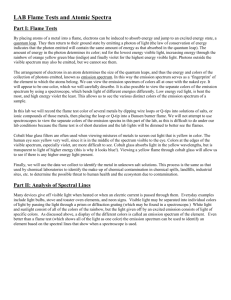FlameTestLab
advertisement

Nicholas Barbier Chemistry Block D 10/24/10 Concerning the Emission Spectra of Elements Introduction: In this lab numerous chemistry principles were addressed. The most obvious of these is the emission spectrum of an element. This is a description of the intensity of different wavelengths of light that are emitted by an element, either when it is burned, or when (if it is a gas) is excited through high voltage electricity. This is a result from electrons, normally in ground state or filling all the lowest energy levels possible, being excited and going into an excited state in which they make a quantum leap to higher energy levels than in the ground state. When the electrons of the atom drop back down into ground state they release the excess energy in the form of the quantum of electromagnetic radiation; the photon, which is observed as light when in the visible spectrum of wavelengths. The elements that are used in this lab are ions instead of atoms due to the reactive nature of pure elemental atoms. This reactivity exists because the electron level of the burned elements only has one or two atoms instead of a full level. The ions of these elements have electron configurations identical to the noble gasses preceding them. Also these elements are even less reactive because they are chlorides, meaning that they have been bonded with chlorine to form a salt; this makes the burning much simpler. Safety Analysis: This lab involves the use of fire and electricity both of which are dangerous manifestations of energy. In order to stay safe students must be required to wear goggles and aprons at all times. Should there be any issue with an out of control fire the gas should be turned off immediately. Also if there are any problems with the electricity and the light bulbs, the bulbs should be unplugged immediately. Should any of these problems occur the student or students involved should, if the teacher has not noticed, get her attention so that she can plan the best course of action needed to deal with any issue. The chemicals used in this lab are not very reactive and do not need to be treated with excess caution. Observations and Data: Element Burning Element Sodium, Na+1 Sodium with cobalt glass Calcium, Ca+1 Copper, Cu+2 Potassium, K+1 Potassium with cobalt glass Strontium, Sr+2 Lithium, Li+1 Sodium & Potassium mixture Sodium & Potassium mixture with cobalt glass Unknown Color Orange/yellow (color of normal flame) White, hints of Neon Blue Dark orange, some green Blue/green, white orange pointy streaks in center (most likely residue) White with slight pink Pink/purple Dark red orange Dark red/pink (wine colored) Bright orange Pink, white at edges Dark red/pink (wine colored) Gas Tubes: Numbers from 0-10 indicate intensity-blank means 0 Gas Tube Red Orange Yellow Green Blue Indigo Violet Hg (blue) 2 5 4 H (bubble gum 1 1 2 9 pink) He 5 9 9 7 8 (purple/white) Ne 9 8 7 2 (orange/yellow) Ar (purple) 2 I (white) 1 1 1 1 1 1 1 O (white with .5 .5 .5 .5 .5 .5 .5 lavender) Light Bulbs Description Description with glasses Fluorescent Bright white color Boxes of all colors of the same shape as the light fixtures. There was more intensity in the green wavelengths with some blue and red. Regular More yellow and a softer A rainbow ray protrudes from color than the fluorescent bulb the bulb. Violet is closest to the bulb and red is farthest from the bulb. The spectrum was the same as the fluorescent but more intensity in the red and orange parts of the spectrum. Energy saver A color in between the Bars of the rainbow spread fluorescent and regular bulbs out from the source with the in terms or the yellow content. strongest wave lengths at green with blue and red at medium intensity. Questions: 1. Li+ or Lithium is the unknown ion because the color of the emission when the unknown ion was burned matches the color of the emission when Lithium or Li+ was burned. 2. This qualitative method is a somewhat practical way to determine the metals in a mixture. Most of the metals flame colors were different enough to allow differentiation with the naked eye; however, should two flame color be similar, because of the inaccuracy of human observation and the introduction of personal bias into results it may be harder to differentiate metals. Perhaps the most effective way to perform this experiment would be to use a spectrometer that takes a measurement much closer to the exact wavelength of the light than is possible with the human eye. 3. The potassium ion in the mixture was the less powerful color. Without the introduction of the cobalt glass the wavelengths of the sodium blocked out the mostly white light (with some pink) of the potassium. When the cobalt glass was introduced the red and orange wavelengths of the sodium flame were absorbed by the glass and only the pink and purple wavelengths of the potassium flame were able to travel through the glass and reach the retina of the human eye. 4. This flame test could be invalids for two clear reasons. The first is simply that the human observer of the flame could be colorblind, preventing them from viewing the color of the flame correctly. Second, the observer may simply have been an inaccurate observer who lacked the ability to correctly describe the color of the flame. 5. A material’s absorption spectrum is a description of the wavelengths of light that this material absorbs as photons pass through it. For example pure white light should have an even spectrum of the entire rainbow when split by a prism; the sun emits white light therefore it should be expected that when refracted, sunlight forms a spectrum with equal quantities of all the colors of the rainbow. This is not the case. There are instead dark lines in the emission spectrum of the sun which represent the absorption spectrum of atmospheric gas. A material’s emission spectrum, on the other hand is a description of the wavelengths of light that a material emits when heated. This is the same as a description of the energy of photons that fall from higher energy levels back down. 6. Helium- Neon- Argon- Krypton- Xenon- Radon- These diagrams show the color of all noble gases which have been energized through a high voltage electric field. The websites used to obtain images for all the noble gases except Radon was Wikipedia; however, the accuracy of these images was confirmed using the website from which the Radon images came from. The only reason for using the Wikipedia images as opposed to the other website’s images was reasons of aesthetics (Wikipedia’s pictures look better). The source that was used for Radon and confirmed Wikipedia’s results is this: Galidakis, I. N. "The Science of Color, the Emission Spectra of the Elements and Some Lamp Engineering Applications." Virtual Composer. N.p., 20 Aug. 2010. Web. 25 Oct. 2010. <http://ioannis.virtualcomposer2000.com/spectroscope/elements.html>. The Wikipedia images can be found at the top right of the respective Wikipedia pages for each element. The website appears to be legitimate for although it is a “.com” website it contains numerous links and references to outside sources. 7. Both the flame test and using a spectroscope (assuming that this spectroscope is the glasses) allowed the viewer to observe what type of electromagnetic radiation (in particular light) was being emitted by the substance. 8. The flame test illustrates the ideas of electrons and energy levels because it shows that elements when burned do emit photons as energy to lower the energy level that they are in. The class learned the Aufbau principle which states that electrons must first fill the lowest vacant energy levels before filling higher energy levels. The class also learned that when excited, electrons jump to higher levels leaving lower levels vacant. This violates the Aufbau principle. In order for the atom to remain in balance the atom must release the extra energy contained by its excited electrons to allow them to occupy again the vacant energy levels. As viewed in this lab, that energy is light in the form of an oscillating photon, the quantum of electromagnetic radiation, at different wavelengths. The eyes of the observer can view these different wavelengths and discern them as different colors. The differing colors between elements are explained by a different number of protons which leads to a different electron configuration in the atom. Another property that was illustrated was that of the different distances between “rungs” in electron energy levels. As seen in the data the elements closer hydrogen or whose electrons in ground state exist at low energy levels on the Periodic Table of the Elements gave off light of wavelengths closer to violet. In other words the elements whose electrons jumped between lower energy levels (i.e. level 2 to 3) instead of higher levels (i.e. level 4 to 5) gave off photons of a higher frequency. A higher frequency of oscillation corresponds to higher energy therefore this demonstrates that the spaces between electron levels are unequal; they become closer with less energy needed for each quantum leap are the levels get higher. 9. Fireworks and makers of fireworks take advantage of human knowledge of the colors that elements burn at. Because fireworks makers know the colors at which elements burn they use they specific elements to gain desired effects in fireworks shows. Fireworks are carefully designed to elements that have specific burn rates at colors and textures that excite wonder in people watching.








